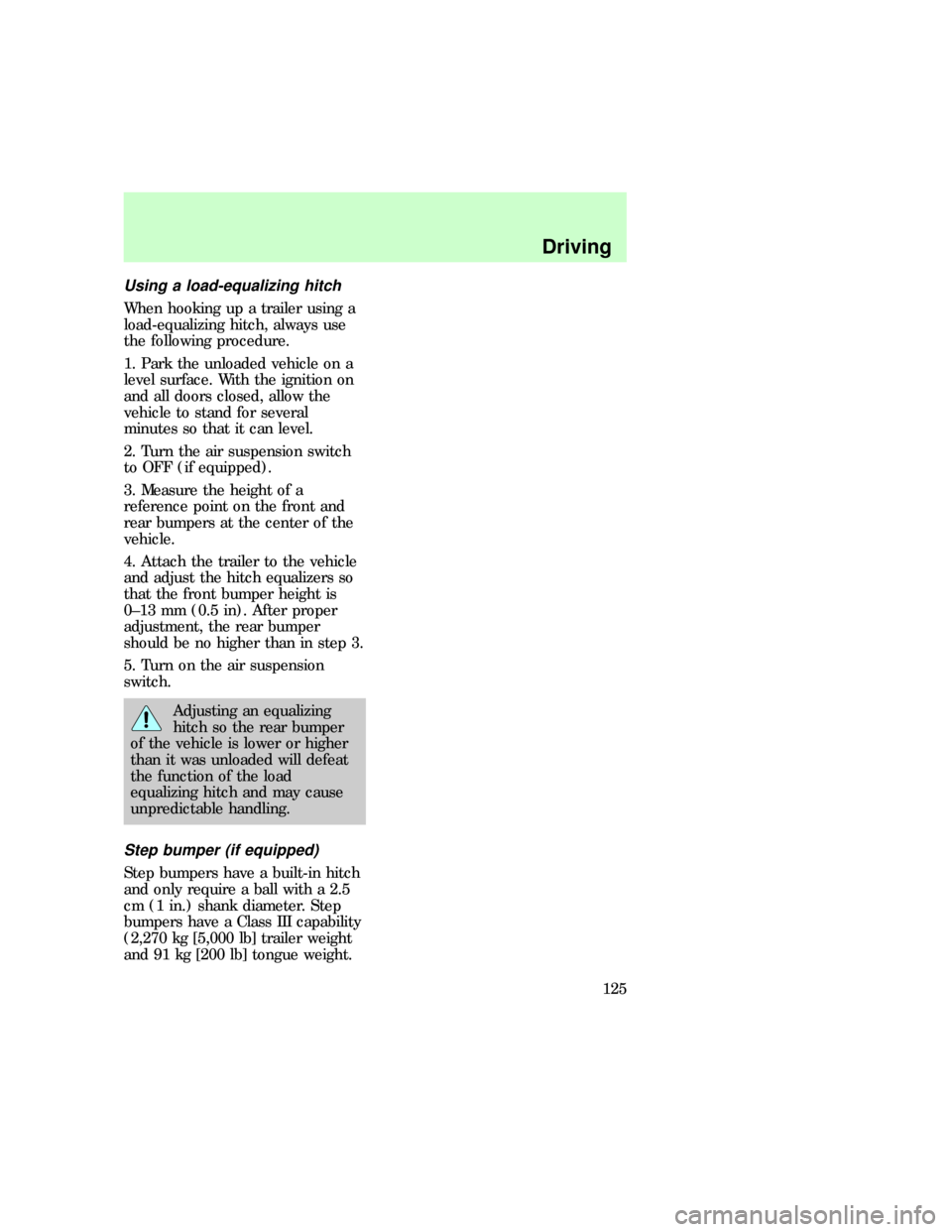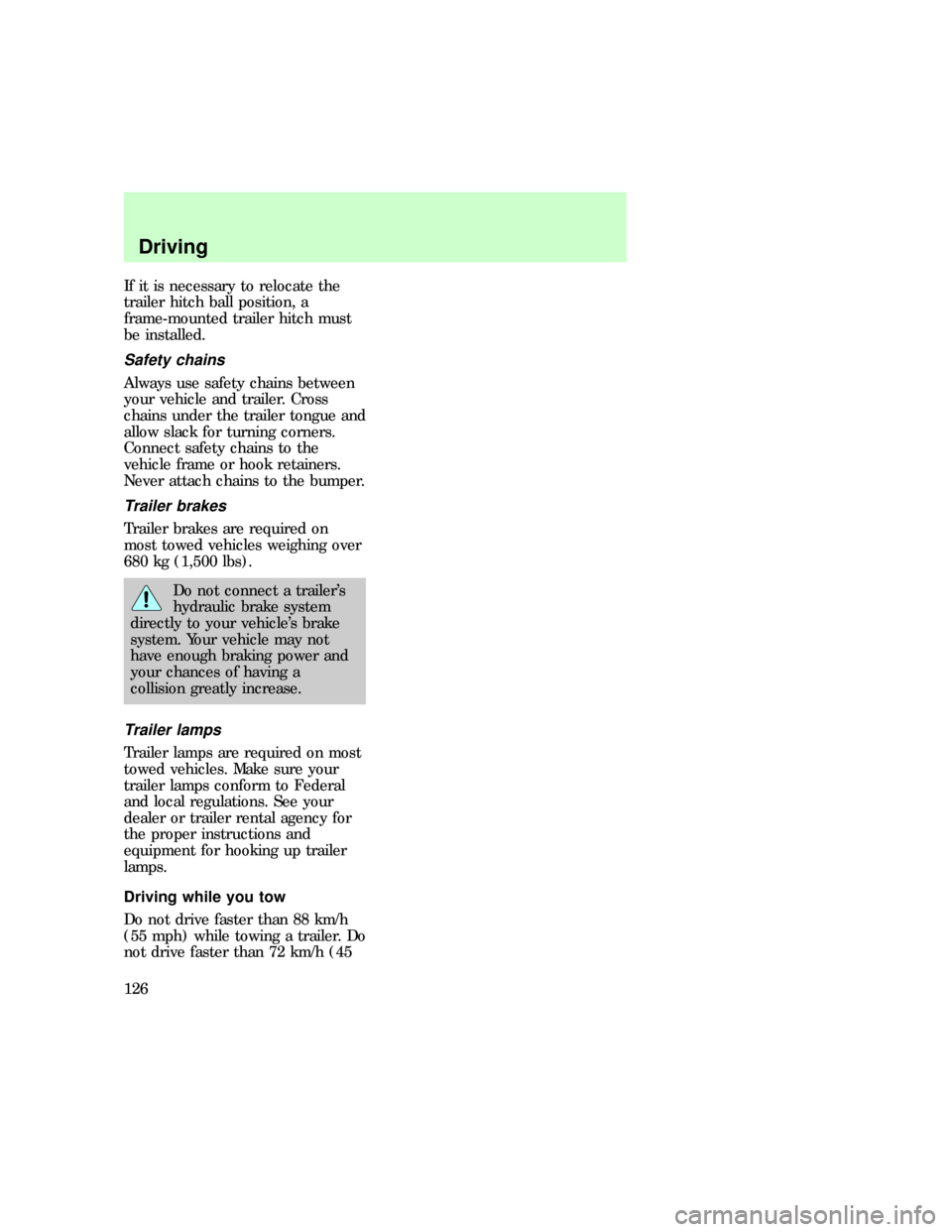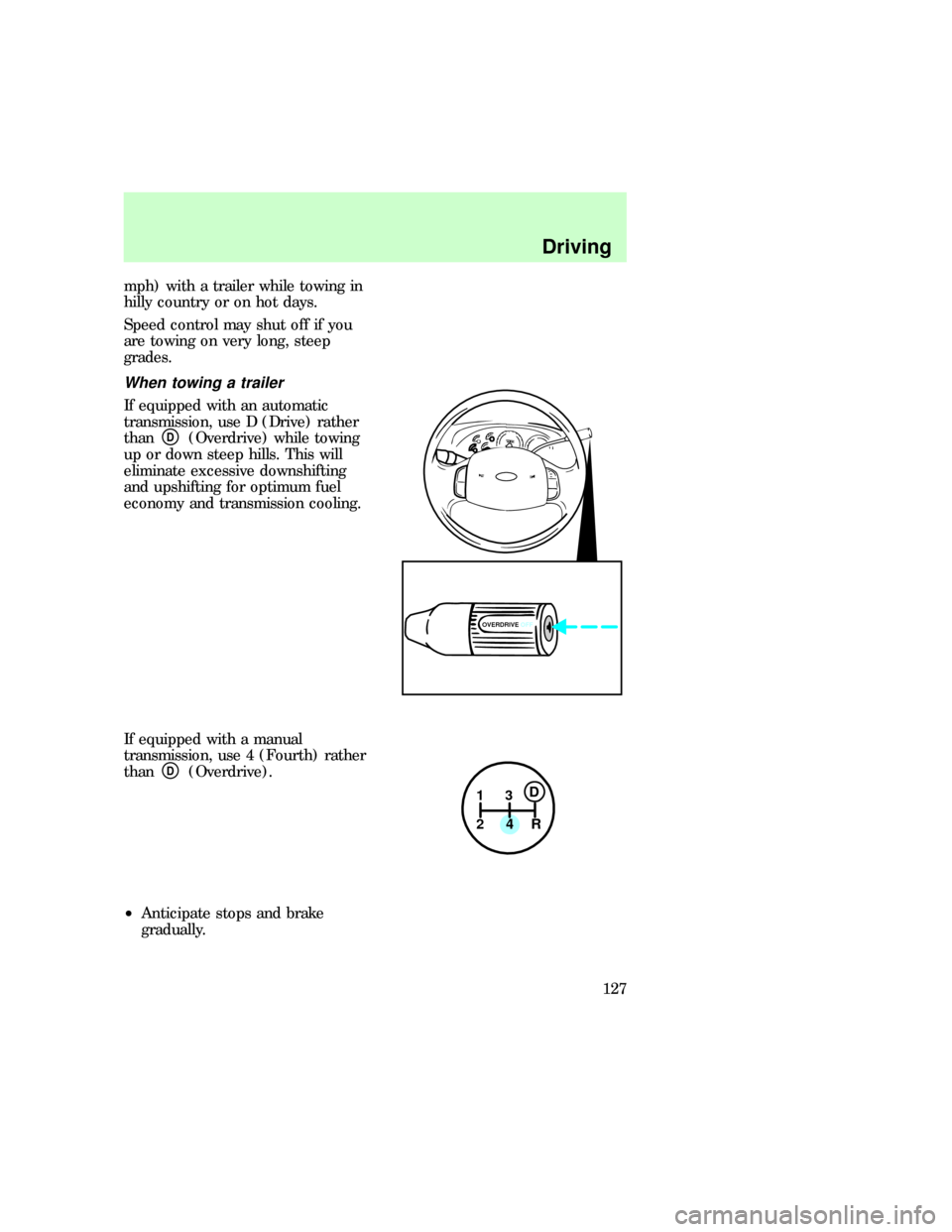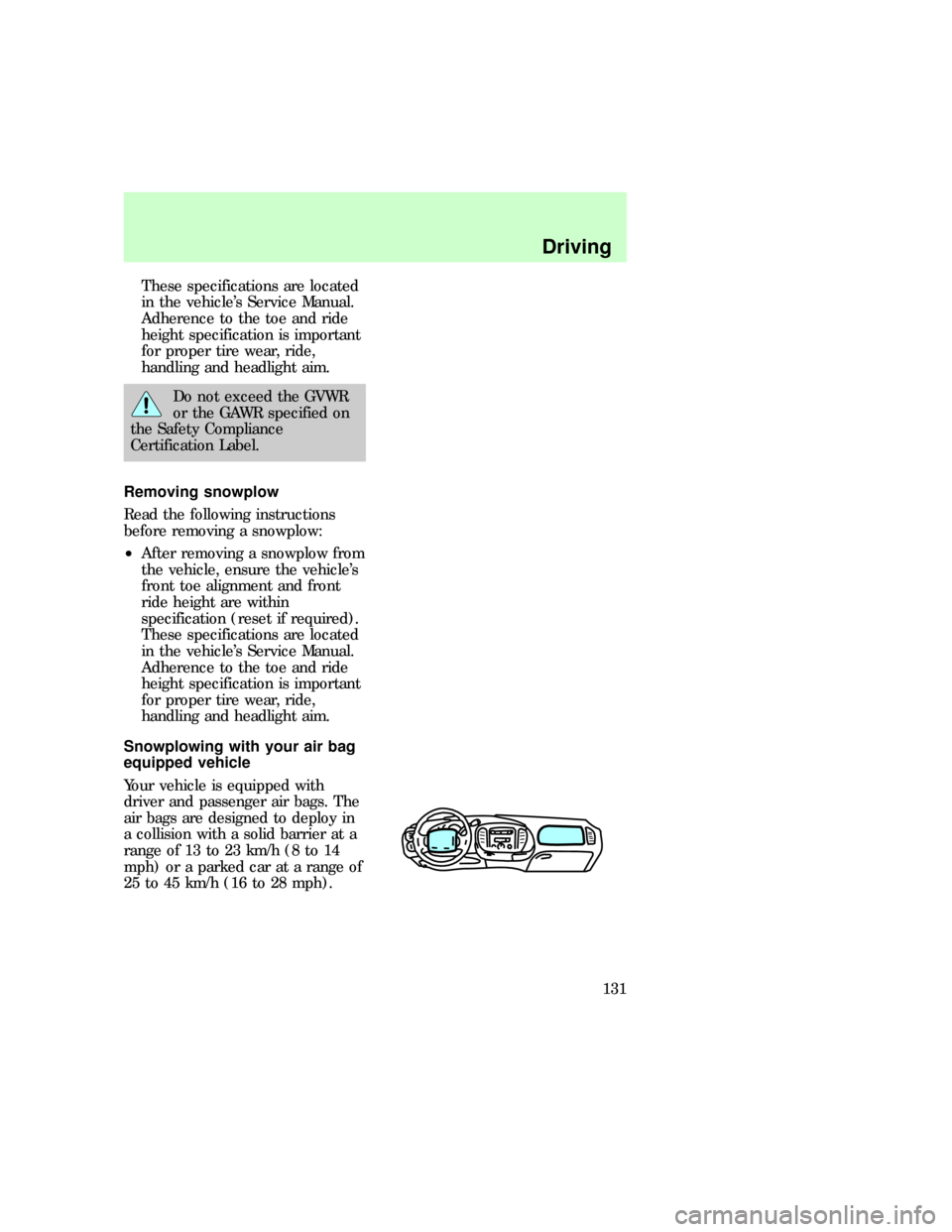FORD F150 1997 10.G Owners Manual
Manufacturer: FORD, Model Year: 1997, Model line: F150, Model: FORD F150 1997 10.GPages: 219, PDF Size: 2.21 MB
Page 121 of 219

Trailer towing table (F-250 4x2 manual transmission)
4.6L 3.31 3,261 (7,200) 1,133 (2,500) 5.52 (60)
4.6L 3.73 3,533 (7,800) 1,406 (3,100) 5.52 (60)
Trailer towing table (F-250 4x4 automatic transmission)
Engine Rear axle
ratioMaximum
GCWR kg (lb)Maximum
trailer weight
kg (lb)Maximum
frontal area of
trailer m
2(ft2)
Regular Cab F-250
4.6L 3.31 4,756 (10,500) 2,449
(5,400)5.52 (60)
4.6L 3.73 5,436 (12,000) 3,129
(6,900)5.52 (60)
5.4L 3.31 5,436 (12,000) 3,084
(6,800)5.52 (60)
5.4L 3.73 6,115 (13,500) 3,764
(8,300)5.52 (60)
SuperCab F-250
4.6L 3.31 4,756 (10,500) 2,449
(5,400)5.52 (60)
4.6L 3.73 5,436 (12,000) 3,129
(6,900)5.52 (60)
5.4L 3.31 5,436 (12,000) 3,084
(6,800)5.52 (60)
5.4L 3.73 6,115 (13,500) 3,764
(8,300)5.52 (60)
Trailer towing table (F-250 4x4 manual transmission)
Engine Rear axle
ratioMaximum
GCWR kg (lb)Maximum
trailer weight
kg (lb)Maximum
frontal area of
trailer m
2(ft2)
Regular Cab F-250
4.6L 3.31 3,261 (7,200) 952 (2,100) 5.52 (60)
Driving
122
Page 122 of 219

Trailer towing table (F-250 4x4 manual transmission)
4.6L 3.73 3,533 (7,800) 1,224
(2,700)5.52 (60)
SuperCab F-250
4.6L 3.31 3,261 (7,200) 952 (2,100) 5.52 (60)
4.6L 3.73 3,533 (7,800) 1,224
(2,700)5.52 (60)
TOWING A TRAILER
Your vehicle may tow a class I, II
or III trailer provided the
maximum trailer weight is less
than or equal to the maximum
trailer weight listed for your engine
and rear axle ratio on the above
charts.
Your vehicle's load capacity is
designated by weight, not by
volume, so you cannot necessarily
use all available space when
loading a vehicle.
Towing a trailer places an
additional load on your vehicle's
engine, transmission, axle, brakes,
tires and suspension. Inspect these
components carefully after any
towing operation.
f12_trailer
Driving
123
Page 123 of 219

Do not exceed the GVWR
or the GAWR specified on
the Safety Compliance
Certification Label.
Towing trailers beyond the
maximum recommended
gross trailer weight could result
in engine damage,
transmission/axle damage,
structural damage, loss of
control, and personal injury.
Preparing to tow
Use the proper equipment for
towing a trailer, and make sure it
is properly attached to your
vehicle. See your dealer or a
reliable trailer dealer if you require
assistance.
Hitches
Do not use or install hitches that:
²clamp onto the vehicle bumper
²attach to the axle.
Underbody hitches are acceptable
if installed properly.
Distribute the load so that only 10
to 15% of the total is on the
tongue. Tie down the load so that
it does not shift and change the
weight on the hitch.
f12_preparing_tow
f12_hitches
Driving
124
Page 124 of 219

Using a load-equalizing hitch
When hooking up a trailer using a
load-equalizing hitch, always use
the following procedure.
1. Park the unloaded vehicle on a
level surface. With the ignition on
and all doors closed, allow the
vehicle to stand for several
minutes so that it can level.
2. Turn the air suspension switch
to OFF (if equipped).
3. Measure the height of a
reference point on the front and
rear bumpers at the center of the
vehicle.
4. Attach the trailer to the vehicle
and adjust the hitch equalizers so
that the front bumper height is
0±13 mm (0.5 in). After proper
adjustment, the rear bumper
should be no higher than in step 3.
5. Turn on the air suspension
switch.
Adjusting an equalizing
hitch so the rear bumper
of the vehicle is lower or higher
than it was unloaded will defeat
the function of the load
equalizing hitch and may cause
unpredictable handling.
Step bumper (if equipped)
Step bumpers have a built-in hitch
and only require a ball with a 2.5
cm (1 in.) shank diameter. Step
bumpers have a Class III capability
(2,270 kg [5,000 lb] trailer weight
and 91 kg [200 lb] tongue weight.
f12_step_bumper
Driving
125
Page 125 of 219

If it is necessary to relocate the
trailer hitch ball position, a
frame-mounted trailer hitch must
be installed.
Safety chains
Always use safety chains between
your vehicle and trailer. Cross
chains under the trailer tongue and
allow slack for turning corners.
Connect safety chains to the
vehicle frame or hook retainers.
Never attach chains to the bumper.
Trailer brakes
Trailer brakes are required on
most towed vehicles weighing over
680 kg (1,500 lbs).
Do not connect a trailer's
hydraulic brake system
directly to your vehicle's brake
system. Your vehicle may not
have enough braking power and
your chances of having a
collision greatly increase.
Trailer lamps
Trailer lamps are required on most
towed vehicles. Make sure your
trailer lamps conform to Federal
and local regulations. See your
dealer or trailer rental agency for
the proper instructions and
equipment for hooking up trailer
lamps.
Driving while you tow
Do not drive faster than 88 km/h
(55 mph) while towing a trailer. Do
not drive faster than 72 km/h (45
f12_safety_chains
f12_trailer_brakes
f12_trailer_lamps
f12_driving_towing
Driving
126
Page 126 of 219

mph) with a trailer while towing in
hilly country or on hot days.
Speed control may shut off if you
are towing on very long, steep
grades.
When towing a trailer
If equipped with an automatic
transmission, use D (Drive) rather
than
D(Overdrive) while towing
up or down steep hills. This will
eliminate excessive downshifting
and upshifting for optimum fuel
economy and transmission cooling.
If equipped with a manual
transmission, use 4 (Fourth) rather
than
D(Overdrive).
²Anticipate stops and brake
gradually.
OVERDRIVE OFF
1
24R3D
f12_when_you_tow
Driving
127
Page 127 of 219

²Allow more room for stopping
with a trailer attached.
²Practice turning, stopping and
backing in an area before
starting on a trip to get the feel
of the vehicle/trailer
combination.
²When turning, drive slightly
beyond the normal turning point
so the trailer wheels will clear
curbs and other obstacles.
²When stopped in traffic for long
periods of time in hot weather,
place the automatic transmission
gearshift in P (Park) to increase
idle speed. This aids engine
cooling and air conditioner
efficiency.
²Vehicles with trailers should not
be parked on a grade. If you
must park on a grade, place
wheel chocks under the trailer's
wheels.
²After you have travelled about
80 km (50 miles), thoroughly
check your hitch, electrical
connections and trailer wheel
lug nuts.
Launching or retrieving a boat
When backing down a ramp during
boat launching or retrieval,
²Do not allow the static water
level to rise above the bottom
edge of the rear bumper and
²Do not allow waves to break
higher than 15 cm (six inches)
above the bottom edge of the
rear bumper.
com_launch-retrieving_boat.01
Driving
128
Page 128 of 219

Exceeding these limits may allow
water to enter critical vehicle
components, adversely affecting
driveability, emissions and
reliability.
Servicing when towing
If you tow a trailer for long
distances, your vehicle will require
more frequent service intervals.
Refer to the ªService Guideº for
more information.
SNOWPLOWING
Ford recommends the following
specifications for low speed,
personal use snow removal:
²F-150 4WD long wheelbase or
F-250 4WD Regular Cab
²4.6L or 5.4L engine
²Super engine cooling
²Heavy duty front suspension
package
²Automatic transmission with
auxiliary automatic transmission
fluid cooling
²All-terrain tires
Do not install a snowplow and
plow with your vehicle until it has
been driven at least 800 km (500
miles).
Installing snowplow
Read the following instructions
before installing a snowplow:
²Front GAWR must not exceed
63% of the GVW. Add ballast
weight to the back of the
f12_service_towing
f12_snowplowing
f12_install_plow
Driving
129
Page 129 of 219

vehicle, if necessary. Refer to
the Safety Compliance
Certification Label to find Front
GAWR.
²The Front Axle Accessory
Reserve Capacity and the Total
Accessory Reserve Capacity
listed on the bottom right of the
Safety Compliance Certification
Label will determine whether or
not the addition of a snowplow
will overload your vehicle.
²The weight of the snowplow and
supporting components
distributed to the front axle
must not exceed the front
accessory reserve capacity.
²The total weight of the
snowplow and aftermarket
equipment must not exceed the
Total Accessory Reserve
Capacity.
²The weight of the installed
snowplow and aftermarket
equipment must not load the
vehicle beyond the GAWR and
GVWR listed on the Safety
Compliance Certification Label.
²Federal and most local
regulations require additional
exterior lamps for
snowplow-equipped vehicles.
Consult your dealer for
additional information.
²After installing a snowplow to
the vehicle, ensure the vehicle's
front toe alignment and front
ride height are within
specification (reset if required).
Driving
130
Page 130 of 219

These specifications are located
in the vehicle's Service Manual.
Adherence to the toe and ride
height specification is important
for proper tire wear, ride,
handling and headlight aim.
Do not exceed the GVWR
or the GAWR specified on
the Safety Compliance
Certification Label.
Removing snowplow
Read the following instructions
before removing a snowplow:
²After removing a snowplow from
the vehicle, ensure the vehicle's
front toe alignment and front
ride height are within
specification (reset if required).
These specifications are located
in the vehicle's Service Manual.
Adherence to the toe and ride
height specification is important
for proper tire wear, ride,
handling and headlight aim.
Snowplowing with your air bag
equipped vehicle
Your vehicle is equipped with
driver and passenger air bags. The
air bags are designed to deploy in
a collision with a solid barrier at a
range of 13 to 23 km/h (8 to 14
mph) or a parked car at a range of
25 to 45 km/h (16 to 28 mph).
f12_remove
f12_snowplow_srs
Driving
131